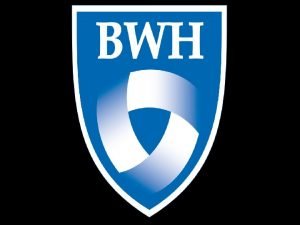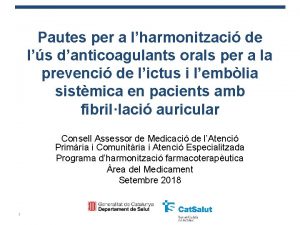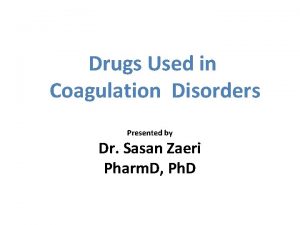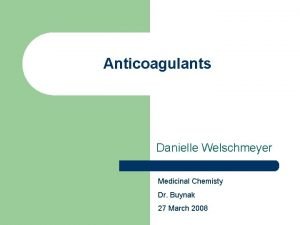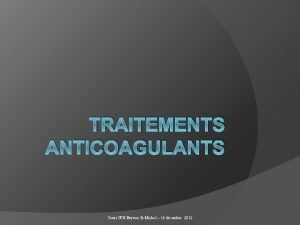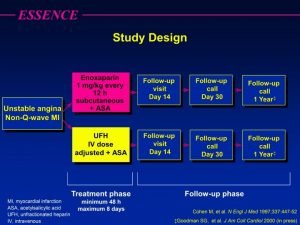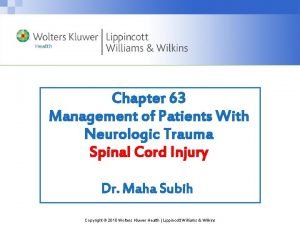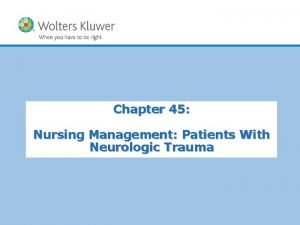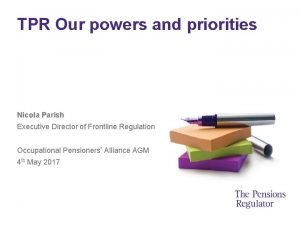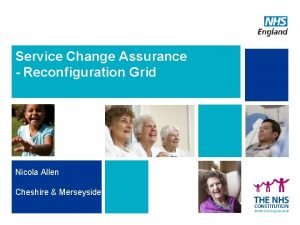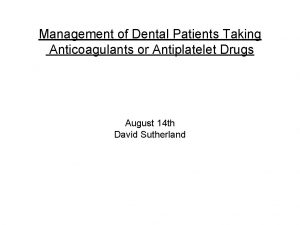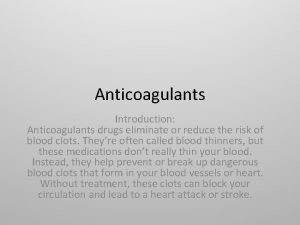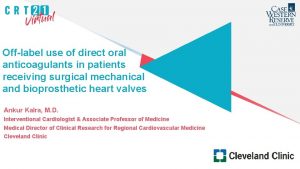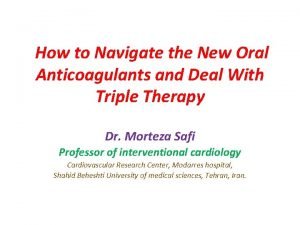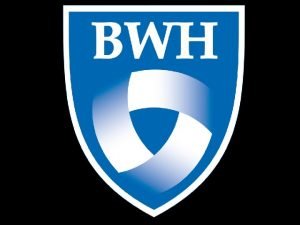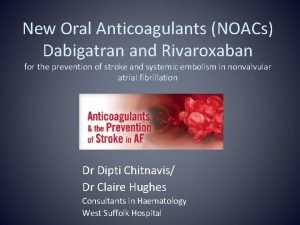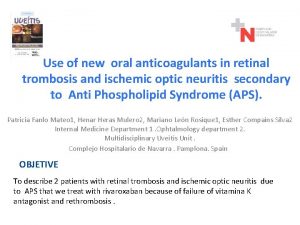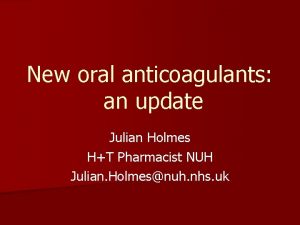Management of patients taking new oral anticoagulants Nicola













- Slides: 13

Management of patients taking new oral anticoagulants Nicola Rivers

Haemostasis • Primary haemostasis • Vasoconstriction • Platelet plug formation, this also activates secondary haemostasis • Secondary haemostasis • Clotting cascade, factors activate each other which forms fibrinogen which forms fibrin proteins that bind to form a clot

Anticoagulants Drugs that work by inhibiting production of factors in the clotting cascade

New oral anticoagulants • Around since 2008, known as NOACs • Are being used instead of warfarin in a number of situations • More predictable -> less/no monitoring • More effective • Safer • Rapid onset 2 -4 hours • NICE recommends use over aspirin in stroke prevention in patients with atrial fibrillation

NOACs - uses • Prevention of stroke in AF - lifelong • Thromboembolic disease – DVT, pulmonary embolism 6 wks-6 mths, can be lifelong • Recent surgery – usually on for 2 -6 weeks

NOACs - concerns • No simple reversal agents available yet • But half lives are short (12 -13 hours) so allow for rapid reduction of effects • INR not suitable for testing coagulation • There are tests but not widely available as they don’t require monitoring

NOACs - drugs • Dabigatran Inhibits coagulation factor thrombin • Apixaban • Rivaroxaban • Edoxaban Inhibit factor Xa of cascade which converts prothrombin to thrombin

Assess bleeding risk Unlikely LA Low risk of post op bleeding Higher risk of post op bleeding Simple XLA’s (1 -3 teeth with limited wound size) Complex XLA’s Supraging scale Incision and drainage of intra-oral swelling XLA of adjacent teeth which causes a large wound Supraging fills/restorations Full pocket chart Flap raising procedures RSI and subging scaling Gingival recontouring Subging fills/restorations Biopsies BPE Endo Prosth Ortho

Low risk treatment • Discuss with patient that they may bleed for longer • Treat without missing or delaying NOAC • Treat early in day • Limit initial treatment area • Local measures - gauze sutures haemostatic packing

Higher risk treatment • Discuss with patient • Explain that interruption of medication is short to minimise thromboembolic risk • • • Miss morning dose of apixaban or dabigatran Delay dose of rivaraxaban Treat early in day Limit treatment area and stage treatment Local measures Restart drug 4 hours after haemostasis or at normal time if later. Take next days dose at normal time

Problems • Advise pt to contact surgery if bleeding restarts with next NOAC dose • Try to avoid missing subsequent dose unless absolutely necessary • Emergency treatment where pt has already taken morning dose – try to delay procedure until later that day

NOACs - interactions • NSAIDs – may increase bleeding risk • Carbemazipine – decreases anticoag effect • Clarithromycin – may increase bleeding risk with dabigatran

References • SDCEP – Management of Dental Patients Taking Anticoagulants or Antiplatelet Drugs August 2015 • Curtin C, Hayes J, Hayes S. Dental Implications of New Oral Anticoagulants for Atrial Fibrillation. Dental Update. 2014; 41: 526 -531.
 Jean connors md
Jean connors md Pauta harmonització anticoagulants
Pauta harmonització anticoagulants Types of anticoagulants
Types of anticoagulants Les anticoagulants ifsi
Les anticoagulants ifsi Les anticoagulants cours ifsi
Les anticoagulants cours ifsi Anticoagulants mechanism of action
Anticoagulants mechanism of action Lippincott williams & wilkins
Lippincott williams & wilkins Management of patients with neurologic trauma
Management of patients with neurologic trauma Periodontal management of medically compromised patients
Periodontal management of medically compromised patients Nicola carozza
Nicola carozza Nicola licata
Nicola licata Nicola cezzi
Nicola cezzi Nicola allen knutsford
Nicola allen knutsford Nicola ann raphael
Nicola ann raphael
